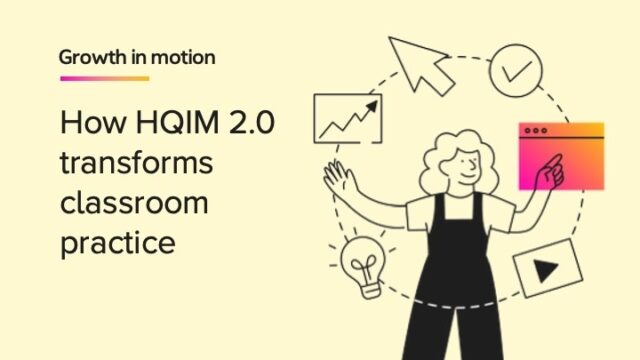
Grade-level proficiency for all students, and interventions for those who need them—that’s the mantra in classrooms today. And with national achievement in math and reading still far below where it should be, it’s not hard to see why educators have placed so much focus on meeting grade-level expectations.
But in the process, one group of students has often been overlooked: advanced learners.
For students who are meeting or exceeding benchmarks but lack the opportunity to take on new challenges, today’s classroom can be a difficult environment. As studies have shown, advanced learners who lack the right kinds of support and opportunity may be at increased risk of underachieving and dropping out.
But in a typical classroom where students have a wide range of learning needs, teachers can lack the time, resources, and support structures to provide advanced learners with appropriate instruction and opportunities. That’s a systemic issue, not a failing of individual teachers. With a handful of practical strategies, supported by leaders and brought to life in the classroom, teachers can usher their advanced learners into a more meaningful and rewarding learning journey. This includes relying less on guesswork and more on proven solutions for identifying who’s ready for acceleration—and getting them the right instruction at the right time.
5 common-sense strategies for supporting advanced learners.
Strategy 1: Curriculum compacting
Why it matters: If you’re a student who’s already mastered the content your class is covering today, wouldn’t you rather explore something new and interesting rather than go through the motions of learning the same content again?
How it works: Curriculum compacting is a technique designed for active young minds. Teachers use various forms of assessment to identify mastered content and put students on a differentiated learning path. Implementation can include a pretest or diagnostic activity (which doesn’t have to be a formal test, just something that produces reliable data), a modular structure with multiple activity options, and quizzes to assess knowledge and keep students moving forward.
Considerations: Curriculum compacting can be a powerful way to differentiate instruction, but it can be challenging to implement. The main challenge is planning time. Making assignments for multiple learning levels and finding the right games, activities, and videos is a lot for teachers to manage. In addition to supporting teachers’ efforts by working to ensure they have adequate planning time, leaders can also invest in time-saving programs that integrate assessment with tailored, challenging learning experiences.
Try this example: Create a “choose your own adventure” style learning map for math instruction. Allow students to select from various activities, and give them brief quizzes when they’re done. For example, if a student completes a two-digit addition activity, you can sign off on it and have them move on to the next one—and the next one after that. But if pretesting reveals that some students have already mastered two-digit addition, you can skip those activities entirely and move them to more challenging content.
Strategy 2: Tiered assignments and open-ended tasks
Why it matters: The more entry points and levels of complexity you build into a learning task or project, the greater alignment you’ll see between students’ current ability and the work they’re performing.
How it works: Tiered assignments and open-ended tasks allow students to spend more time in that just-right place (the zone of proximal development) where they’re challenged to explore their intellectual boundaries. For example, by offering them a choice to write one sentence, one paragraph, or several paragraphs on a given topic, you can assess content knowledge in a flexible way that doesn’t commit every student to a standardized task that may not suit all of them.
Considerations: Tiered assignments and open-ended tasks give students agency by letting them decide how to engage with the assigned content.
Try this example: Use the RAFT writing strategy (role, audience, format, topic) for history assignments. Have students choose a perspective from a historical event or period, like the Revolutionary War, and express that viewpoint in the format that most appeals to them. For example, students on grade level might write an imagined diary entry or a simple letter to a historical figure, while advanced learners might develop comprehensive research projects exploring the same time period.
Strategy 3: Student-driven inquiry or passion projects
Why it matters: “The best thing about letting students explore their passions and interests is that absolutely everyone can be part of it,” says Dryw Freed, an NWEA content specialist and former classroom teacher with expertise in working with gifted students. “I once had a 10-year-old student with behavioral challenges—in part, because he was gifted and needed positive ways to apply his attention. When he told me he was interested in quantum computing, I was able to find some age-appropriate resources to help him explore his interest.”
How it works: Student-led inquiry creates a space where students of very different academic performance levels can collaborate effectively. When students are engrossed in the same topic, they are less likely to be distracted by differences in their performance levels.
Considerations: Time constraints can be a barrier to letting students pursue their own interests or projects. Creative scheduling, whether it’s using lunch periods for learning activities or letting motivated students have recess indoors so they can continue working on their projects, can be a lifesaver for teachers who may already feel there are not enough hours in the day.
Try this example: Allow students to explore topics they’re passionate about, such as sports or popular culture. When pairing students for collaborative work on these projects, focus on shared interests rather than academic ability. Additionally, think creatively about how teachers in non-core subjects could be engaged to contribute to students’ learning priorities.
Strategy 4: Flexible grouping and peer mentorship
Why it matters: At all levels of education, from kindergarten to post-grad, peer learning groups and mentorships have a critical role to play in students’ learning and development. The opportunity to collaborate with peers at similar or higher achievement levels can be particularly beneficial for advanced learners.
How it works:
- Purpose-driven student grouping. Collaborative groups can look very different depending on the nature of the activity. For passion projects, for example, you can successfully group students from varying academic performance levels, while a book discussion group may work better with members who are more closely aligned in their reading ability. This focus on purpose naturally leads to flexible grouping, as groups are formed around specific activities for only as long as students need to reach their short-term learning goals.
- Careful classroom composition. When it comes time to form learning groups or pair students in mentoring relationships, you’ll want some options for how to go about it—and that means ensuring that each classroom has a “deep bench” of student diversity. Dryw Freed explains: “With cluster grouping, you make sure there’s not just one kid in the class who’s advanced.”
- Thoughtful pairing. Peer mentorships work best when partners are close enough in ability to relate to each other, yet different enough to create meaningful growth opportunities. This is especially important for advanced learners, whose progress can stall if they’re always in the position of leading rather than learning.
Considerations: Forming learning groups and pairing students with mentors is a balancing act that requires perceptiveness on the teacher’s part. The teacher will need to assess what each student has to offer—not only academic knowledge, but also interpersonal skills as well.
Try this example: Implement cluster grouping to ensure multiple advanced learners are placed in each classroom, providing options for forming small instructional groups. Create mentorship pairings where advanced students work with peers who can challenge them intellectually, which will give them the valuable experience of learning from others, rather than always being the highest performer in the group.

Strategy 5: Leveraging technology to support teachers’ efforts
Why it matters: Nothing can replace teachers’ intuition and judgment, but technology and automation can deliver a major assist to their efforts, beginning with high-quality assessment data and continuing with a personalized instruction pathway for each student.
How it works: Administrators can support teachers’ efforts by investing in integrated platforms that both identify students who are ready for acceleration and automatically deliver appropriately challenging content to those students. With an integrated platform, teachers maintain control while receiving continuous data, guidance, and feedback to ensure their advanced learners are consistently engaged and challenged at the peak of their ability.
Considerations: The strategies discussed take time to implement, and they all have in common the need for accurate baseline data so that teachers know exactly where students are in their learning before putting them in groups, pairing them up with peer mentors, or otherwise differentiating their learning. Additionally, it’s important to remember that while technology is a powerful resource, it’s the teacher’s judgment and ongoing attention that makes differentiation meaningful and effective.
Try this example: Explore technology-powered solutions that connect assessment data with personalized learning pathways, ensuring that advanced learners can easily access engaging content that will challenge them to grow.
Additional considerations for leaders
As teachers look to offer more and better support to their advanced learners, school and district leaders can back their efforts in a number of important ways:
- Ample planning time. To give advanced learners the space and opportunity to grow, teachers need dedicated time to design the right activities and enrichments for these learners. While this may look different in every school and every classroom, the key idea is that openness to creative scheduling and a commitment to giving teachers plenty of time to collaborate and plan will result in more meaningful learning experiences for all students—especially the advanced learners who are all too often overlooked.
- Professional learning. As teachers work to meet the needs of their advanced learners, professional development focused specifically on differentiation for this group can be an invaluable source of practical guidance and inspiration.
- Flexible pacing policies. There’s a balance to be struck between keeping classes on the same general trajectory as they move through their curricula while allowing for differentiation that accounts for diverse learning needs. Depending on the distribution of advanced learners, some classes may need to speed up and some may need to slow down.
- A culture of growth for all students. Growth is for everyone—not just students performing below benchmark. While limited time and resources will always be a challenge given the wide variety of needs in a typical classroom, it’s important to remember that support for advanced learners will keep them engaged and reduce their risk of underachievement.
In a grade-level-focused world, advanced learners thrive when instruction adapts to their strengths, offers meaningful challenge, and provides opportunities to grow beyond expectations. Tools that pair ongoing data with differentiated pathways can help educators do this consistently and equitably.
***
With real-time data and personalization, HMH Personalized Path provides every learner the tools they need to reach their full potential.
Build a data-driven culture in your school or district.














